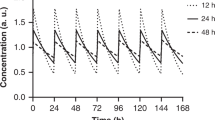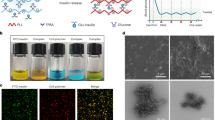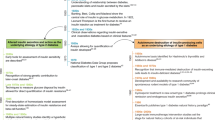Abstract
The concept of a glucose-responsive insulin (GRI) has been a recent objective of diabetes technology. The idea behind the GRI is to create a therapeutic that modulates its potency, concentration or dosing relative to a patient's dynamic glucose concentration, thereby approximating aspects of a normally functioning pancreas. From the perspective of the medicinal chemist, the GRI is also important as a generalized model of a potentially new generation of therapeutics that adjust potency in response to a critical therapeutic marker. The aim of this Perspective is to highlight emerging concepts, including mathematical modelling and the molecular engineering of insulin itself and its potency, towards a viable GRI. We briefly outline some of the most important recent progress toward this goal and also provide a forward-looking viewpoint, which asks if there are new approaches that could spur innovation in this area as well as to encourage synthetic chemists and chemical engineers to address the challenges and promises offered by this therapeutic approach.
This is a preview of subscription content, access via your institution
Access options
Access Nature and 54 other Nature Portfolio journals
Get Nature+, our best-value online-access subscription
$29.99 / 30 days
cancel any time
Subscribe to this journal
Receive 12 print issues and online access
$259.00 per year
only $21.58 per issue
Buy this article
- Purchase on Springer Link
- Instant access to full article PDF
Prices may be subject to local taxes which are calculated during checkout



Similar content being viewed by others
Change history
24 November 2017
In the version of this Perspective originally published, the affiliations for authors Zhen Gu and Sanjoy Dutta were not correct, they should have read: Zhen Gu3,4,5, Sanjoy Dutta6. 3Joint Department of Biomedical Engineering, University of North Carolina at Chapel Hill and North Carolina State University, Raleigh, North Carolina 27695, USA. 4Pharmacoengineering and Molecular Pharmaceutics Division, Eshelman School of Pharmacy, University of North Carolina at Chapel Hill, Chapel Hill, North Carolina 27599, USA. 5Department of Medicine, University of North Carolina School of Medicine, Chapel Hill, North Carolina 27599, USA. 6JDRF International, New York, New York 10004, USA.
References
Owens, D. R., Zinman, B. & Bolli, G. B. Insulins today and beyond. Lancet 358, 739–46 (2001).
IDF Diabetes Atlas 6th Edn (International Diabetes Federation, 2013).
Heller, S., Kozlovski, P. & Kurtzhals, P. Insulin's 85th anniversary — an enduring medical miracle. Diabetes Res. Clin. Pract. 78, 149–58 (2007).
Barnett, A. H. & Owens, D. R. Drug profile: insulin analogues. Lancet 349, 47–51 (1997).
Evans, M., Schumm-Draeger, P. M., Vora, J. & King, A. B. A review of modern insulin analogue pharmacokinetic and pharmacodynamic profiles in type 2 diabetes: improvements and limitations. Diabetes. Obes. Metab. 13, 677–84 (2011).
Heise, T. & Pieber, T. R. Towards peakless, reproducible and long-acting insulins. An assessment of the basal analogues based on isoglycaemic clamp studies. Diabetes. Obes. Metab. 9, 648–59 (2007).
Zaykov, A. N., Mayer, J. P. & DiMarchi, R. D. Pursuit of a perfect insulin. Nat. Rev. Drug Discov. https://doi.org/10.1038/nrd.2015.36 (2016).
Sheldon, B., Russell-Jones, D. & Wright, J. Insulin analogues: an example of applied medical science. Diabetes. Obes. Metab. 11, 5–19 (2009).
Kurtzhals, P. et al. Albumin binding of insulins acylated with fatty acids: characterization of the ligand–protein interaction and correlation between binding affinity and timing of the insulin effect in vivo. Biochem. J. 312, 725–731 (1995).
Home, P. Insulin glargine: the first clinically useful extended-acting insulin in half a century? Expert Opin. Investig. Drugs. 8, 307–314 (1999).
Jonassen, I. et al. Biochemical and physiological properties of a novel series of long-acting insulin analogs obtained by acylation with cholic acid derivatives. Pharm. Res. 23, 49–55 (2006).
Kurtzhals, P., Kiehr, B. & Sørensen, A. R. The cobalt(III)-insulin hexamer is a prolonged-acting insulin prodrug. J. Pharm. Sci. 84, 1164–8 (1995).
Malik, L. et al. Perfluoroalkyl chains direct novel self-assembly of insulin. Langmuir 28, 593–603 (2012).
Jonassen, I. et al. Design of the novel protraction mechanism of insulin degludec, an ultra-long-acting basal insulin. Pharm. Res. 29, 2104–14 (2012).
Vienberg, S. G. et al. Receptor-isoform-selective insulin analogues give tissue-preferential effects. Biochem. J. 440, 301–308 (2011).
Hua, Q. X. et al. Design of an active ultrastable single-chain insulin analog: synthesis, structure, and therapeutic implications. J. Biol. Chem. 283, 14703–14716 (2008).
Edgerton, D. S. et al. Changes in glucose and fat metabolism in response to the administration of a hepato-preferential insulin analog. Diabetes 63, 3946–3954 (2014).
Lee, D. & Yannakakis, M. Principles and methods of testing finite state machines — a survey. Proc. IEEE 84, 1090–1123 (1996).
Man, C. D., Raimondo, D. M., Rizza, R. A. & Cobelli, C. GIM, simulation software of meal glucose–insulin model. J. Diabetes Sci. Technol. 1, 323–330 (2007).
Cobelli, C., Renard, E. & Kovatchev, B. Artificial pancreas: past, present, future. Diabetes 60, 2672–2682 (2011).
Kovatchev, B. P., Breton, M., Dalla Man, C. & Cobelli, C. In Silico preclinical trials: a proof of concept in closed-loop control of type 1 diabetes. J. Diabetes Sci. Technol. 3, 44–55 (2009).
Dalla Man, C., Rizza, R. A. & Cobelli, C. Meal simulation model of the glucose–insulin system. IEEE Trans. Biomed. Eng. 54, 1740–1749 (2007).
Boutayeb, A. & Chetouani, A. A critical review of mathematical models and data used in diabetology. Biomed. Eng. Online 5, 43 (2006).
Chou, D. H.-C. et al. Glucose-responsive insulin activity by covalent modification with aliphatic phenylboronic acid conjugates. Proc. Natl Acad. Sci. USA. 112, 2401–2406 (2015).
Sorensen, J. T. A Physiologic Model of Glucose Metabolism in Man and its Use to Design and Assess Improved Insulin Therapies for Diabetes PhD dissertation, Massachusetts Institute of Technology (1985).
Bisker, G., Iverson, N. M., Ahn, J. & Strano, M. S. A pharmacokinetic model of a tissue implantable insulin sensor. Adv. Healthc. Mater. 4, 87–97 (2015).
Parker, R. S., Doyle, F. J. III & Peppas, N. A. A model-based algorithm for blood glucose control in type I diabetic patients. IEEE Trans. Biomed. Eng. 46, 148–157 (1999).
Parker, R. S., Doyle, F. J. I., Ward, J. H. & Peppas, N. A. Robust H∞ glucose control in diabetes using a physiological model. AIChE J. 46, 2537–2549 (2000).
Parker, R. S., Doyle III, F. J. & Peppas, N. A. The intravenous route to blood glucose control. Eng. Med. Biol. Mag. IEEE 20, 65–73 (2001).
Heller, J., Chang, A. C., Rood, G. & Grodsky, G. M. Release of insulin from pH-sensitive poly(ortho esters). J. Control. Release 13, 295–302 (1990).
Albin, G., Horbett, T. A. & Ratner, B. D. Glucose sensitive membranes for controlled delivery of insulin: insulin transport studies. J. Control. Release 2, 153–164 (1985).
Ishihara, K., Kobayashi, M., Ishimaru, N. & Shinohara, I. Glucose induced permeation control of insulin through a complex membrane consisting of immobilized glucose oxidase and a poly(amine). Polym. J. 16, 625–631 (1984).
Gu, Z. et al. Injectable nano-network for glucose-mediated insulin delivery. ACS Nano 7, 4194–4201 (2013).
Gu, Z. et al. Glucose-responsive microgels integrated with enzyme nanocapsules for closed-loop insulin delivery. ACS Nano 7, 6758–6766 (2013).
Veiseh, O., Tang, B. C., Whitehead, K. a, Anderson, D. G. & Langer, R. Managing diabetes with nanomedicine: challenges and opportunities. Nat. Rev. Drug Discov. 14, 45–57 (2015).
Brownlee, M. & Cerami, A. A glucose-controlled insulin-delivery system: semisynthetic insulin bound to lectin. Science 206, 1190–1191 (1979).
Tiegs, G., Hentschel, J. & Wendel, A. AT cell-dependent experimental liver injury in mice inducible by concanavalin A. J. Clin. Invest. 90, 196 (1992).
Bull, S. D. et al. Exploiting the reversible covalent bonding of boronic acids: recognition, sensing, and assembly. Acc. Chem. Res. 46, 312–326 (2012).
Matsumoto, A. et al. A synthetic approach toward a self‐regulated insulin delivery system. Angew. Chemie Int. Ed. 51, 2124–2128 (2012).
Fischel-Ghodsian, F., Brown, L., Mathiowitz, E., Brandenburg, D. & Langer, R. Enzymatically controlled drug delivery. Proc. Natl Acad. Sci. USA 85, 2403–2406 (1988).
Podual, K., Doyle, F. J. & Peppas, N. A. Glucose-sensitivity of glucose oxidase-containing cationic copolymer hydrogels having poly(ethylene glycol) grafts. J. Control. Release 67, 9–17 (2000).
Tai, W. et al. Bio-inspired synthetic nanovesicles for glucose-responsive release of insulin. Biomacromolecules 15, 3495–3502 (2014).
Podual, K., Doyle, F. J. & Peppas, N. A. Preparation and dynamic response of cationic copolymer hydrogels containing glucose oxidase. Polymer (Guildf). 41, 3975–3983 (2000).
Holtz, J. H. & Asher, S. A. Polymerized colloidal crystal hydrogel films as intelligent chemical sensing materials. Nature 389, 829–832 (1997).
Goldraich, M. & Kost, J. Glucose-sensitive polymeric matrices for controlled drug delivery. Clin. Mater. 13, 135–142 (1993).
Yu, J. et al. Microneedle-array patches loaded with hypoxia-sensitive vesicles provide fast glucose-responsive insulin delivery. Proc. Natl Acad. Sci. USA 112, 8260–8265 (2015).
Grodsky, G. M., Curry, D., Landahl, H. & Bennett, L. [Further studies on the dynamic aspects of insulin release in vitro with evidence for a two-compartmental storage system]. Acta Diabetol Lat 6, 554–578 (1969).
Webber, M. J. & Anderson, D. G. Smart approaches to glucose-responsive drug delivery. J. Drug Target. 23, 651–655 (2015).
Hansen, J. S., Christensen, J. B., Petersen, J. F., Hoeg-Jensen, T. & Norrild, J. C. Arylboronic acids: A diabetic eye on glucose sensing. Sens. Actuators B-Chem. 161, 45–79 (2012).
Peppas, N. A. Is there a future in glucose-sensitive, responsive insulin delivery systems? J. Drug Deliv. Sci. Technol. 14, 247–256 (2004).
Webber, M. J., Anderson, D. G. & Langer, R. S. Engineering synthetically modified insulin for glucose-responsive diabetes therapy. Expert Rev. Endocrinol. Metab. 10, 483–489 (2015).
James, T. D., Phillips, M. D. & Shink, S. in Boronic Acids in Saccharide Recognition 3–176 (The Royal Society of Chemistry, 2006).
Huang, Y.-J. et al. Glucose sensing via aggregation and the use of 'knock-out' binding to improve selectivity. J. Am. Chem. Soc. 135, 1700–3 (2013).
Springsteen, G. & Wang, B. A detailed examination of boronic acid–diol complexation. Tetrahedron 58, 5291–5300 (2002).
Springsteen, G. & Wang, B. Alizarin Red S. as a general optical reporter for studying the binding of boronic acids with carbohydrates. Chem. Commun. https://doi.org/10.1039/b104895n (2001).
Arimori, S., Ward, C. J. & James, T. D. A D-glucose selective fluorescent assay. Tetrahedron Lett. 43, 303–305 (2002).
Dowlut, M. & Hall, D. G. An improved class of sugar-binding boronic acids, soluble and capable of complexing glycosides in neutral water. J. Am. Chem. Soc. 128, 4226–4227 (2006).
Hansen, J. S., Christensen, J. B., Solling, T. I., Jakobsen, P. & Hoeg-Jensen, T. Ortho-substituted aryl monoboronic acids have improved selectivity for D-glucose relative to D-fructose and L-lactate. Tetrahedron 67, 1334–1340 (2011).
Martinez-Aguirre, M. A., Villamil-Ramos, R., Guerrero-Alvarez, J. A. & Yatsimirsky, A. K. Substituent effects and pH profiles for stability constants of arylboronic acid diol esters. J. Org. Chem. 78, 4674–4684 (2013).
Yan, J., Springsteen, G., Deeter, S. & Wang, B. The relationship among pKa, pH, and binding constants in the interactions between boronic acids and diols — it is not as simple as it appears. Tetrahedron 60, 11205–11209 (2004).
Hoeg-Jensen, T. Preparation and Screening of diboronate arrays for identification of carbohydrate binders. QSAR Comb. Sci. 23, 344–351 (2004).
Yang, W., He, H. & Drueckhammer, D. G. Computer-guided design in molecular recognition: design and synthesis of a glucopyranose receptor. Angew Chem Int Ed 40, 1714–1718 (2001).
Davis, A. P. & James, T. D. in Functional Synthetic Receptors (Schrader, T. & Hamilton, A. D.) 45–109 (Wiley-VCH, 2005).
Walsh, G. Therapeutic insulins and their large-scale manufacture. Appl. Microbiol. Biotechnol. 67, 151–159 (2005).
Baeshen, N. A. et al. Cell factories for insulin production. Microb. Cell. Fact. 13, 141 (2014).
Keasling, J. D., Mendoza, A., Baran, P. S. & Bernstein, H. D. Synthesis: a constructive debate. Nature 492, 188–189 (2012).
Liu, F., Zaykov, A. N., Levy, J. J., Dimarchi, D. & Mayer, J. P. Chemical synthesis of peptides within the insulin superfamily. J. Pept. Sci. 22, 260–270 (2016).
Liu, F., Luo, E. Y., Flora, D. B. & Mezo, A. R. A synthetic route to human insulin using isoacyl peptides. Angew. Chemie Int. Ed. 53, 3983–3987 (2014).
Liu, F., Luo, E. Y., Flora, D. B. & Mayer, J. P. Concise synthetic routes to human insulin. Org. Lett. 15, 960–963 (2013).
Mayer, J. P., Zhang, F. & DiMarchi, R. D. Insulin structure and function. Pept. Sci. 88, 687–713 (2007).
Tofteng, A. P., Jensen, K. J., Schäffer, L. & Hoeg-Jensen, T. Total synthesis of desB30 insulin analogues by biomimetic folding of single-chain precursors. Chembiochem 9, 2989–2996 (2008).
Avital-Shmilovici, M. et al. Fully convergent chemical synthesis of ester insulin: determination of the high resolution X-ray structure by racemic protein crystallography. J. Am. Chem. Soc. 135, 3173–3185 (2013).
Zaykov, A. N., Mayer, J. P., Gelfanov, V. M. & Dimarchi, R. D. Chemical synthesis of insulin analogs through a novel precursor. ACS Chem. Biol. 9, 683–691 (2014).
Royo, M., Alsina, J., Giralt, E., Slomcyznska, U. & Albericio, F. S-Phenylacetamidomethyl (Phacm): an orthogonal cysteine protecting group for Boc and Fmoc solid-phase peptide synthesis strategies. J. Chem. Soc. Perkin Trans. https://doi.org/10.1038/P19950001095 (1995).
Karas, J. A. et al. 2-Nitroveratryl as a photocleavable thiol-protecting group for directed disulfide bond formation in the chemical synthesis of insulin. Chem. A Eur. J. 20, 9549–9552 (2014).
Hoeg-Jensen, T. et al. Insulins with built-in glucose sensors for glucose responsive insulin release. J. Pept. Sci. 11, 339–46 (2005).
Hoeg-Jensen, T., Havelund, S., Nielsen, P. K. & Markussen, J. Reversible insulin self-assembly under carbohydrate control. J. Am. Chem. Soc. 127, 6158–9 (2005).
Menting, J. G. et al. Protective hinge in insulin opens to enable its receptor engagement. Proc. Natl Acad. Sci. USA. 111, E3395–404 (2014).
Nakagawa, S. H. & Tager, H. S. Perturbation of insulin-receptor interactions by intramolecular hormone cross-linking. Analysis of relative movement among residues A1, B1, and B29. J. Biol. Chem. 264, 272–279 (1989).
Derewenda, U. et al. X-ray analysis of the single chain B29-A1 peptide-linked insulin molecule. A completely inactive analogue. J. Mol. Biol. 220, 425–433 (1991).
Hua, Q. X. et al. Mini-proinsulin and mini-IGF-I: homologous protein sequences encoding non-homologous structures. J. Mol. Biol. 277, 103–118 (1998).
Zion, T. C. & Lancaster, T. M. Soluble non-depot insulin conjugates and uses thereof. US patent 2014003769 (2012).
Lin, S. et al. Glucose-responsive insulin conjugates. US patent WO 2015051 (2015).
Menting, J. G. et al. How insulin engages its primary binding site on the insulin receptor. Nature 493, 241–245 (2013).
Berenson, D., Weiss, A. R., Wan, Z.-L. & Weiss, M. A. Insulin analogs for the treatment of diabetes mellitus: therapeutic applications of protein engineering. Ann. N. Y. Acad. Sci. 1243, E40–E54 (2012).
Drejer, K. The bioactivity of insulin analogues from in vitro receptor binding to in vivo glucose uptake. Diabetes Metab. Rev. 8, 259–285 (1992).
Acknowledgements
The authors would like to acknowledge the Joint JDRF and Helmsley Charitable Trust sponsored Workshop on 'Design and Development of Glucose Responsive Insulins' held in New York, April 2016. The American Diabetes Association (ADA; 1-15-ACE-21) and the JDRF Diabetes Foundation (3-SRA-2015-117-Q-R; 2-SRA-2016-269-A-N); the Leona M. and Harry B. Helmsley Charitable trust (Award 2014PG-T1D002). All correspondence and requests for materials should be addressed to M.S.S.
Author information
Authors and Affiliations
Contributions
N.B. and A.C. compiled and edited the paper. N.B. and M.S. contributed to the mathematical modelling. Z.G. contributed to the section of Biomimetic GRI formulations. A.C., M.W., S.D., D.A. and R.L. contributed to the section on engineered insulins with glucose recognition. All authors discussed and commented on the manuscript.
Corresponding author
Ethics declarations
Competing interests
The authors declare no competing financial interests.
Rights and permissions
About this article
Cite this article
Bakh, N., Cortinas, A., Weiss, M. et al. Glucose-responsive insulin by molecular and physical design. Nature Chem 9, 937–944 (2017). https://doi.org/10.1038/nchem.2857
Received:
Accepted:
Published:
Issue Date:
DOI: https://doi.org/10.1038/nchem.2857
This article is cited by
-
Week-long normoglycaemia in diabetic mice and minipigs via a subcutaneous dose of a glucose-responsive insulin complex
Nature Biomedical Engineering (2023)
-
Controlled delivery of a neurotransmitter–agonist conjugate for functional recovery after severe spinal cord injury
Nature Nanotechnology (2023)
-
Enhanced hexamerization of insulin via assembly pathway rerouting revealed by single particle studies
Communications Biology (2023)
-
Silk fibroin/chitosan pH-sensitive controlled microneedles
Journal of Materials Science (2023)
-
Material design for oral insulin delivery
Med-X (2023)



